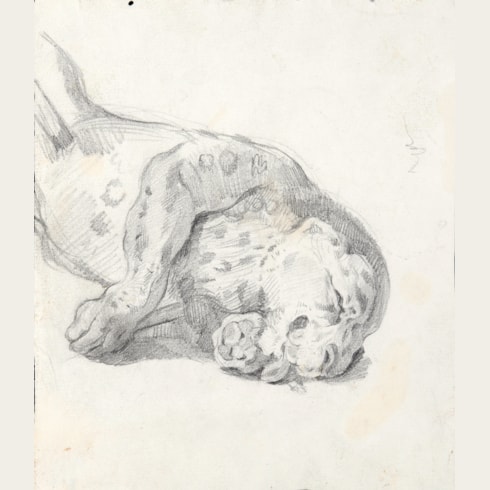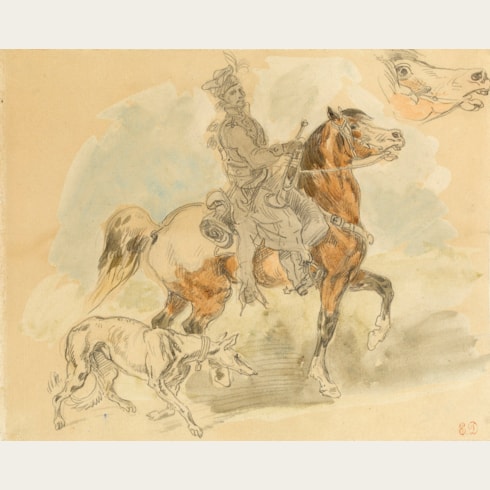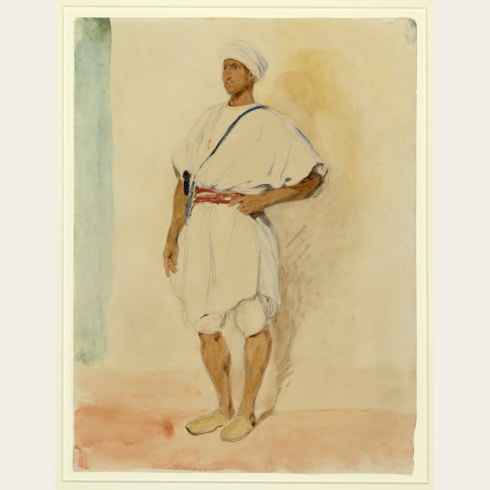Eugène DELACROIX
(Charenton-Saint Maurice 1798 - Paris 1863)
A View of Eaux-Bonnes in the Pyrénées
Sold
Watercolour over an underdrawing in pencil on paper, backed.
171 x 295 mm. (6 3/4 x 11 5/8 in.)
171 x 295 mm. (6 3/4 x 11 5/8 in.)
Eugène Delacroix produced relatively few landscape drawings, apparently because he regarded landscape as a background for his paintings and not necessarily as a subject in itself. (He never exhibited a landscape painting at the Salon.) Although his use of watercolour for landscape sketches was inspired by his visit to England in 1826 and his friendship with the artist Richard Parkes Bonington, it was not until the 1840s that he regularly made landscape studies in the medium. During this period he produced watercolour landscapes of the scenery around his country home at Champrosay, near Fontainebleau, and also near the home of his friend George Sand at Nohant in central France. These works, however, were never exhibited but were kept in his studio until his death. Delacroix’s revived interest in landscape from the 1840s onwards can be seen as, to some extent, the result of a series of travels he made to the mountains, the seaside and the country for the sake of his health, as well as an increasing desire for solitude and a respite from the demands made on him by his work in Paris.
In the summer of 1845, on the advice of his doctor, Delacroix spent about a month – between 22 July and 15 August - in the small thermal spa town of Eaux-Bonnes, at the foot of the Pyrenees. (The artist was exhausted from working concurrently on the decorative schemes for the Palais Bourbon and the Palais du Luxembourg, on which he had been engaged for the previous five or six years, and had been sent to the spa to rest and recover his strength.) During his time in Eaux-Bonnes he took long walks in the mountainous countryside surrounding the fashionable spa town, making countless drawings and sketches of the scenery; the banks of the Valentin river and the villages of the Ossau Valley, the canyon at Gourzy and the mountain peak known as the Pic de Ger.
As Delacroix wrote from Eaux-Bonnes to his friend Frédéric Villot, in a letter of 24 July 1845, just after his arrival in the town: ‘The landscape is beautiful. It is the mountains in all their majesty. There are truly delightful sites at every step, at every bend in the trail: if you have the legs of a goat to climb the rises then you will have the complete enjoyment of the countryside.’ In another letter, to his cousin Léon Riesener, he writes, ‘The natural landscape is very beautiful here. There are mountains wherever you turn, and the visual effect is magnificent. What surprised me the most, even more than their beauty, is the indifference with which everyone looks at them, including the artists, such as [Camille] Roqueplan and [Paul] Huet, both of whom I found here.’
However, while he was struck with the majesty of the mountains around Eaux-Bonnes, Delacroix seems to have regarded them as challenging to paint. As he wrote on August 5th to a friend, ‘The beauty of this scenery of the Pyrenees is not something that one can hope to render with painting in a happy way. Regardless of the impossibility of working continuously here, it is all too gigantic and one does not know where to start in the midst of these masses and this multitude of details’, while on the same day he also wrote to Villot that ‘the gigantic and all of that confounds me. There is never paper big enough to give an idea of these masses and the details are so numerous that no amount of patience can triumph over them.’ (He also complained about the weather at Eaux-Bonnes, writing in another letter, ‘Here it seems to be by design; this place is a sort of funnel where all the clouds congregate. It rains almost all the time and the fact is that if the waters are good for curing stubborn colds, there is no better place for catching one.’)
Previously unpublished, this free and fresh study of a view near Eaux-Bonnes may be compared with a handful of equally atmospheric watercolours by Delacroix, in particular five studies of the mountains of the Pyrenees in the Louvre. Also similar to the present sheet is a watercolour of a mountain landscape at Eaux-Bonnes in the British Museum and another in the Yale University Art Gallery in New Haven. Apart from several examples in the Louvre, other watercolours by Delacroix of landscapes in the Pyrenees are today in the collections of the Art Institute of Chicago and the Pierpont Morgan Library in New York. In addition to a number of independent drawings and watercolours, a sketchbook used by the artist between July and August 1845 survives from this period in the Pyrenees, and was recently acquired by the Louvre. The Louvre sketchbook includes several watercolour landscapes that are closely comparable to the present sheet.
Delacroix’s landscape watercolours, with their fluidity of wash and delicacy of touch, reveal that the artist could more than hold his own in this challenging medium. He tended to use very diluted watercolours to achieve the effects he wanted, and, rather than applying gouache or white heightening, preferred to leave the whitish reserve of the paper to serve as highlights. As he noted in his journal in 1847, ‘The particular charm of watercolour, against which all oil painting invariably appears red and pissing, lies in the constant transparency of the paper; the proof is that it loses this quality when a little gouache is applied. It [ie. this transparency] is lost entirely in a gouache.’ Such spirited watercolours as the present sheet are, in the words of one scholar, ‘a painter’s sketches, free from the manual and intellectual habits of the watercolor specialist and the illustrator.’
In the summer of 1845, on the advice of his doctor, Delacroix spent about a month – between 22 July and 15 August - in the small thermal spa town of Eaux-Bonnes, at the foot of the Pyrenees. (The artist was exhausted from working concurrently on the decorative schemes for the Palais Bourbon and the Palais du Luxembourg, on which he had been engaged for the previous five or six years, and had been sent to the spa to rest and recover his strength.) During his time in Eaux-Bonnes he took long walks in the mountainous countryside surrounding the fashionable spa town, making countless drawings and sketches of the scenery; the banks of the Valentin river and the villages of the Ossau Valley, the canyon at Gourzy and the mountain peak known as the Pic de Ger.
As Delacroix wrote from Eaux-Bonnes to his friend Frédéric Villot, in a letter of 24 July 1845, just after his arrival in the town: ‘The landscape is beautiful. It is the mountains in all their majesty. There are truly delightful sites at every step, at every bend in the trail: if you have the legs of a goat to climb the rises then you will have the complete enjoyment of the countryside.’ In another letter, to his cousin Léon Riesener, he writes, ‘The natural landscape is very beautiful here. There are mountains wherever you turn, and the visual effect is magnificent. What surprised me the most, even more than their beauty, is the indifference with which everyone looks at them, including the artists, such as [Camille] Roqueplan and [Paul] Huet, both of whom I found here.’
However, while he was struck with the majesty of the mountains around Eaux-Bonnes, Delacroix seems to have regarded them as challenging to paint. As he wrote on August 5th to a friend, ‘The beauty of this scenery of the Pyrenees is not something that one can hope to render with painting in a happy way. Regardless of the impossibility of working continuously here, it is all too gigantic and one does not know where to start in the midst of these masses and this multitude of details’, while on the same day he also wrote to Villot that ‘the gigantic and all of that confounds me. There is never paper big enough to give an idea of these masses and the details are so numerous that no amount of patience can triumph over them.’ (He also complained about the weather at Eaux-Bonnes, writing in another letter, ‘Here it seems to be by design; this place is a sort of funnel where all the clouds congregate. It rains almost all the time and the fact is that if the waters are good for curing stubborn colds, there is no better place for catching one.’)
Previously unpublished, this free and fresh study of a view near Eaux-Bonnes may be compared with a handful of equally atmospheric watercolours by Delacroix, in particular five studies of the mountains of the Pyrenees in the Louvre. Also similar to the present sheet is a watercolour of a mountain landscape at Eaux-Bonnes in the British Museum and another in the Yale University Art Gallery in New Haven. Apart from several examples in the Louvre, other watercolours by Delacroix of landscapes in the Pyrenees are today in the collections of the Art Institute of Chicago and the Pierpont Morgan Library in New York. In addition to a number of independent drawings and watercolours, a sketchbook used by the artist between July and August 1845 survives from this period in the Pyrenees, and was recently acquired by the Louvre. The Louvre sketchbook includes several watercolour landscapes that are closely comparable to the present sheet.
Delacroix’s landscape watercolours, with their fluidity of wash and delicacy of touch, reveal that the artist could more than hold his own in this challenging medium. He tended to use very diluted watercolours to achieve the effects he wanted, and, rather than applying gouache or white heightening, preferred to leave the whitish reserve of the paper to serve as highlights. As he noted in his journal in 1847, ‘The particular charm of watercolour, against which all oil painting invariably appears red and pissing, lies in the constant transparency of the paper; the proof is that it loses this quality when a little gouache is applied. It [ie. this transparency] is lost entirely in a gouache.’ Such spirited watercolours as the present sheet are, in the words of one scholar, ‘a painter’s sketches, free from the manual and intellectual habits of the watercolor specialist and the illustrator.’
Eugène Delacroix has long been recognized as one of the finest draughtsmen of the 19th century in France. Adept in a variety of techniques – notably pen, pencil, watercolour, charcoal and pastel - he produced a large and diverse number of drawings of all types. As a modern scholar has noted, ‘For their number, variety and importance he attached to them, drawings are an essential, if not fundamental part of Delacroix’s oeuvre…they represent the most faithful testimonies of the man and the artist with his foibles but his greatness as well.’
However, Delacroix’s output as a draughtsman remained almost completely unknown and unseen by scholars, collectors and connoisseurs until the posthumous auction of the contents of his studio held in February 1864, six months after the artist’s death, which included some six thousand drawings in 430 lots. The sale included not only preparatory compositional sketches and figure studies for Delacroix’s paintings and public commissions, but a myriad variety of drawings by the artist, including studies of wild animals, landscapes, copies after the work of earlier masters, costume studies, scenes from literature, still life subjects and the occasional portrait, as well as finished pastels. In the words of the Delacroix scholar Lee Johnson, ‘It came as a surprise to many that an artist who had been so consistently criticized throughout his career for incompetence as a draughtsman and laxity in composition was revealed by the many hundreds of graphic works, the fifty-five sketchbooks, and scores of oil sketches at his sale to have been a draughtsman of extraordinary versatility and one who went to infinite pains to elaborate the compositions of his paintings through preliminary studies of many kinds, from the inchoate scribbles of an idea in germ, to more articulate designs, to detailed drawings of pose and gesture.’
The largest single collection of drawings by Delacroix, numbering almost three thousand individual sheets and twenty-three sketchbooks, is today in the Louvre.
Provenance
The artist’s studio, Paris (Lugt 838a)
The Delacroix atelier sale, Paris, Hôtel Drouot, 17-29 February 1864, probably part of lot 595 (‘Études de muletiers et de paysannes. Vues de montagnes. Aquarelles et dessins. 27 feuilles.’, bt. Richy)
Probably A. Richy, Paris
Private collection, France
Galerie Schmit, Paris, in 2000
Acquired from them by Eugene V. Thaw, New York
Thence by descent.
The Delacroix atelier sale, Paris, Hôtel Drouot, 17-29 February 1864, probably part of lot 595 (‘Études de muletiers et de paysannes. Vues de montagnes. Aquarelles et dessins. 27 feuilles.’, bt. Richy)
Probably A. Richy, Paris
Private collection, France
Galerie Schmit, Paris, in 2000
Acquired from them by Eugene V. Thaw, New York
Thence by descent.










